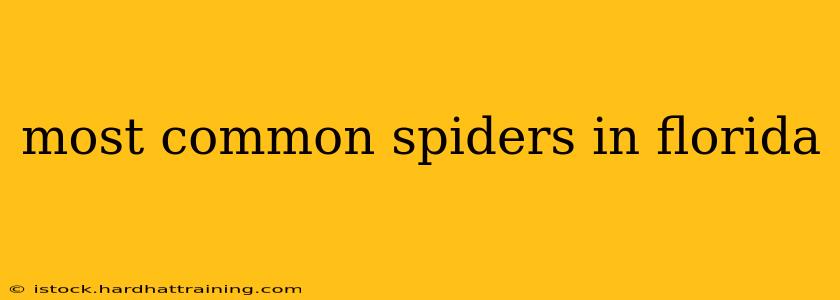Florida's warm, humid climate provides a perfect habitat for a diverse array of spiders, many of which are harmless to humans. However, understanding which spiders are prevalent in the Sunshine State is crucial for safety and peace of mind. This guide explores some of the most common spiders found in Florida, detailing their identification, behavior, and potential dangers.
Identifying Common Florida Spiders
While hundreds of spider species call Florida home, several stand out due to their frequency and visibility. Remember, accurate identification is key to assessing potential risks. If you're unsure about a spider's identity, it's always best to err on the side of caution and avoid handling it.
1. Orb Weavers (Family Araneidae):
- Appearance: Orb weavers are known for their intricate, circular webs. They come in various sizes and colors, often exhibiting bright, striking patterns. Many have large, round abdomens.
- Habitat: Found in gardens, yards, and around homes, often building their webs in shrubs, trees, and corners of buildings.
- Danger Level: Generally harmless to humans. Their bite is rarely medically significant, similar to a mild bee sting.
2. Wolf Spiders (Family Lycosidae):
- Appearance: Large, hairy spiders with excellent eyesight. They are typically brown or gray, with distinctive markings.
- Habitat: Live in burrows in the ground or under rocks and logs. They are often found in wooded areas, fields, and gardens.
- Danger Level: While possessing venomous fangs, their bite is usually not dangerous to humans. It might cause localized pain, swelling, and itching, but rarely requires medical attention.
3. Jumping Spiders (Family Salticidae):
- Appearance: Small to medium-sized spiders with excellent vision and jumping abilities. They are often brightly colored and display diverse patterns.
- Habitat: Found in a wide variety of habitats, from gardens and houses to forests and fields.
- Danger Level: Harmless to humans. Their bite is not considered medically significant.
4. Yellow Sac Spiders (Genus Cheiracanthium):
- Appearance: Pale yellow or greenish-yellow spiders, typically small and relatively inconspicuous.
- Habitat: Found in leaf litter, under rocks, and sometimes indoors. They often create irregular webs.
- Danger Level: Their bite can cause localized pain, swelling, and sometimes a necrotic lesion (tissue death). While generally not life-threatening, medical attention might be needed in severe cases.
5. Black Widows (Genus Latrodectus):
- Appearance: Easily recognizable by their shiny, black bodies and a distinctive red hourglass marking on the underside of their abdomen.
- Habitat: Prefer dark, sheltered areas like woodpiles, sheds, and under rocks.
- Danger Level: Their bite is considered medically significant due to the neurotoxic venom. Symptoms can include muscle pain, cramps, nausea, and vomiting. Seek immediate medical attention if bitten.
6. Brown Recluses (Genus Loxosceles):
- Appearance: Light brown to dark brown spiders with a distinctive fiddle-shaped marking on their cephalothorax (head and chest).
- Habitat: While native to other parts of the US, brown recluses are not commonly found in Florida. Misidentifications are frequent.
- Danger Level: While their venom can cause necrotic lesions, their presence in Florida is questionable. Again, proper identification is paramount before assuming it's a brown recluse.
Minimizing Spider Encounters in Your Home
Several preventative measures can help minimize spider encounters:
- Cleanliness: Regularly clean and vacuum your home, paying attention to corners, crevices, and cluttered areas.
- Exterior Maintenance: Seal cracks and gaps in your home's foundation and exterior walls. Keep vegetation trimmed away from the house.
- Pest Control: Addressing other insects that spiders prey on can help reduce spider populations.
When to Seek Medical Attention
While most Florida spider bites are not dangerous, it's essential to seek immediate medical attention if you experience:
- Severe pain: Intense or spreading pain that doesn't subside.
- Rapid swelling: Significant and rapid swelling around the bite site.
- Systemic symptoms: Nausea, vomiting, fever, muscle cramps, or difficulty breathing.
This guide provides an overview of common Florida spiders. Always prioritize safe observation and seek professional help if you encounter a spider you can't identify or if a bite causes concerning symptoms. Remember, the vast majority of spiders are beneficial to the ecosystem and pose no threat to humans.
